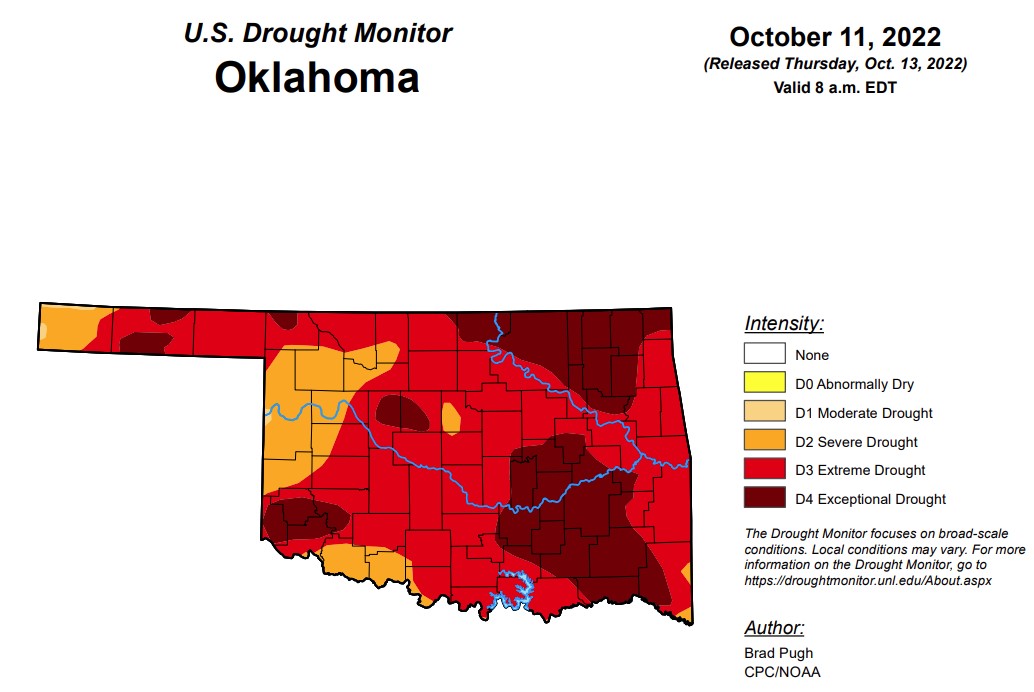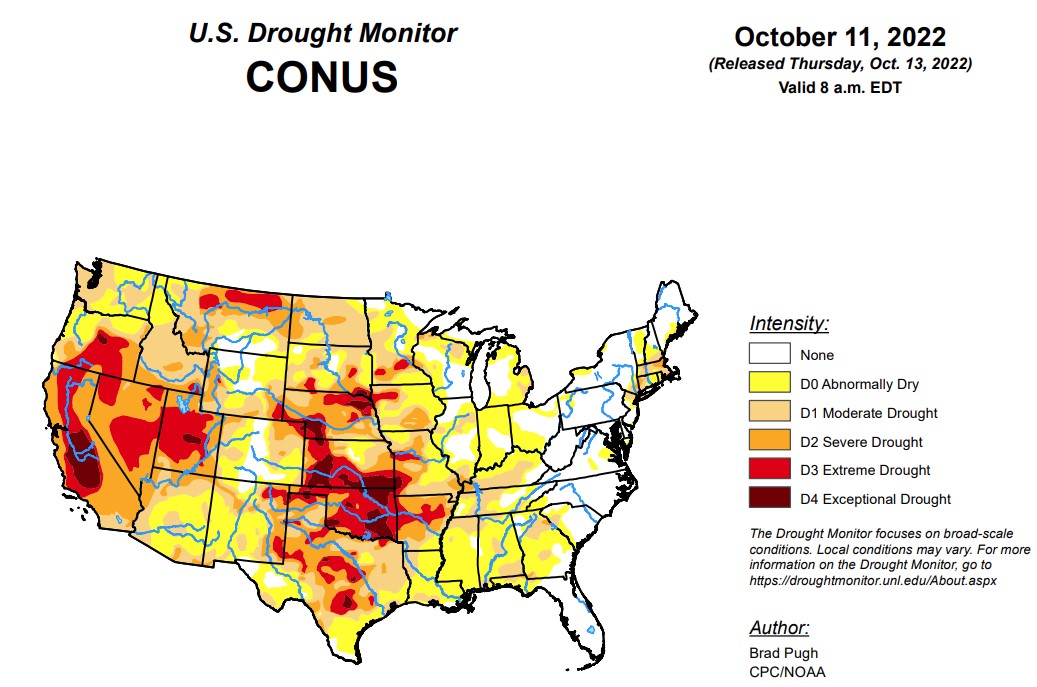Thu, 13 Oct 2022 12:05:27 CDT
The Oklahoma Farm Bureau Fire Department Matching Program donated a total of $61,300 to rural fire departments around the state of Oklahoma.
The program – a collaboration between OKFB, the OKFB Foundati…

Oct 13
Thu, 13 Oct 2022 12:05:27 CDT
The Oklahoma Farm Bureau Fire Department Matching Program donated a total of $61,300 to rural fire departments around the state of Oklahoma.
The program – a collaboration between OKFB, the OKFB Foundati…
Oct 13
Thu, 13 Oct 2022 11:40:54 CDT

An Oklahoma State University scientist is studying how beneficial microorganisms help plants acquire nutrients.
Through an almost $1 million grant from the National Institute of Food and Agriculture, Feng Feng, assistant professor in the OSU Department of Biochemistry and Molecular Biology, will study the interactions between plants and beneficial microorganisms. The microbes infect plant roots to establish a mutually beneficial relationship with the plant called symbiosis. This relationship provides plants with essential nutrients, such as nitrogen and phosphorus.
Much like people, plants are naturally exposed to a wide variety of microorganisms, some good and some bad, and they have an immune system that triggers defense responses to limit infection. To establish this symbiotic relationship with plants, microbes suppress a plant’s immune system.
Feng said the microbes can produce signal molecules called lipo-chitooligosaccharides (LCOs). The LCOs are recognized by a plant receptor called NFP, and it is this recognition that triggers symbiosis, which hinders the plant’s immunity to infection.
“What we want to know now is how do microbes use LCOs to hinder immunity for plant infections?” Feng said.
Feng and his colleagues at the University of Cambridge in the United Kingdom will work on a legume species called Medicago truncatula and barley to understand the molecular process that causes root microbes to suppress immune systems in plants.
“The underlying molecular mechanisms that regulate plant immunity during early symbiotic infection are still largely unclear,” he said. “This project aims to identify a set of plant genes that are required for LCOs to suppress plant immune systems.”
Once the genes have been identified in Medicago truncatula, Feng and his colleagues hope to place them into barley to determine if they enhance the plant’s ability to take in soil nutrients and fight Fusarium graminearum, a fungal disease that causes head blight in small-grain cereals.
“Our research might also bring new insights into engineering nitrogen-fixing symbioses into cereal crops, an important approach to sustaining cereal yields and reducing dependence on inorganic fertilizers,” Feng said.
This material is based upon work supported by the AFRI Competitive Grant under award number 2022-67014-38607 for $916,258 from the USDA National Institute of Food and Agriculture. Any opinions, findings, conclusions or recommendations expressed in this publication are those of the author(s) and do not necessarily reflect the view of the U.S. Department of Agriculture.
OSU Ag Research is Oklahoma’s premier research and technology development agency in agriculture, natural resources and the life sciences.
Oct 13
Thu, 13 Oct 2022 11:23:31 CDT
Congressman Frank Lucas (OK-03) will hold town hall meetings in Alfalfa, Grant, Garfield, Noble, and Logan Counties on Wednesday, October 19th and Thursday, October 20th. Residents around the locations are i…
Oct 13
Thu, 13 Oct 2022 10:16:30 CDT
The American Farm Bureau Federation today released its priorities for what may be the most consequential legislation for agriculture in 2023 – renewal of the farm bill. The priorities were identified by a wo…
Oct 13
Thu, 13 Oct 2022 09:57:01 CDT

Oklahoma is now facing the most extreme/exceptional drought that is has seen since February of 2013 at 85.6 percent extreme drought or worse.
In Oklahoma, exceptional drought is at 29.1 percent, up significantly from last week’s 17.78 percent.
Extreme drought or worse is now at 85.6, up about ten percentage points from last week’s 75.7 percent.
Severe drought or worse is up to 99.6 percent, up slightly from last week’s 99.5 percent.
Moderate drought or worse is up to 100 percent, up slightly from last week’s 99.9 percent.
Abnormally dry or worse conditions remain at 100 percent.
According to the 6-10-day precipitation outlook map for Oklahoma, a 40-50 percent chance of precipitation through October 22, with the southwest corner of the state and the panhandle leaning below a 33-40 percent chance of precipitation.
To view the Oklahoma Drought Map, click here.
According to the latest U.S. drought monitor, following a drier-than-normal September for a majority of the contiguous U.S., this dry pattern continued into early October for many areas. Therefore, drought coverage increased and intensified throughout the Pacific Northwest, Great Plains, Ohio River Valley, and Southeast. From October 4-10, heavy rainfall (1 to 3 inches) was limited to the northern Mid-Atlantic, southern New England, and parts of the Southwest. New Mexico was especially wet this past week and this much above-normal precipitation extended eastward into west Texas. 7-day temperatures, ending on October 10, averaged above-normal across the West. Cooler-than-normal temperatures were observed from the Mississippi Valley to the East Coast with the first freeze of the season affecting parts of the Midwest.
To view the U.S. Drought Map, click here.
In the Southern Plains, widespread, heavy precipitation (1 to 3 inches) during early October along with a wet 2022 Monsoon supported large-scale improvements across New Mexico. These improving drought conditions extended eastward to include western Texas. During the past week, rainfall amounts ranged from 2 to 4 inches, locally more, across the Davis Mountains, Trans Pecos, and southern Permian Basin of western Texas. Farther to the east across central and eastern Texas, another week of degradations were made. Based on 120-day, soil moisture, and impact reports, the coverage of D3 (extreme) to D4 (exceptional) drought was expanded across parts of Oklahoma. Rainfall was not enough to justify any improvements in southwestern Oklahoma with little to no response in soil moisture. Increasing 30-day deficits resulted in a 1-category degradation across parts of Arkansas, Louisiana, Mississippi, and Tennessee. The expanding D3 area in Arkansas was based on 30 to 60-day SPI and soil moisture indicators.
In the High Plains, 30 to 120-day SPI along with soil moisture indicators supported expansion of moderate drought (D1) throughout northern and eastern North Dakota. Based on a consensus of indicators, severe drought (D2) was added to central North Dakota. Severe (D2) to extreme (D3) drought was expanded slightly across east-central Nebraska based on SPI at multiple time scales and soil moisture. Likewise, these indicators supported a 1-category degradation in parts of south-central and southwestern South Dakota. Impact reports from these areas of South Dakota include: zero soil moisture down to three feet on several fields and low stock ponds. The most widespread degradations made to Kansas were in northeast and east-central parts of the state, consistent with 90 to 120-day SPEI along with soil moisture indicators. An expansion of abnormal dryness (D0) and moderate drought (D1) was made to southeastern Colorado, based on 30-day SPIs, declining soil moisture and streamflows, and very dry VegDRI. Conversely, heavy rainfall (1 to 2 inches) since the beginning of October prompted a 1-category improvement for parts of southwestern Colorado. Slight improvements were justified across northwestern Wyoming, due to positive values of 30 to 90-day SPI and favorable soil moisture response from recent precipitation.
In the West, increasing 90-day precipitation deficits of more than 6 inches and above-normal temperatures during September resulted in the continued expansion of moderate drought (D1) across western Washington and northwest Oregon. SPI values, soil moisture indicators, and 28-day streamflows strongly support D1 in these areas. According to the NCEI statewide rankings, Montana had its warmest July-August-September on record. Based on the 90-day SPEI along with 24-month SPI, extreme drought (D3) was expanded across northern Montana. D3 was eliminated in parts of eastern Montana due to the lack of support from SPI and SPEI values at various time scales. Based on longer-term SPIs and local feedback, 1-category improvements were made to parts of Utah along with bordering northeast Nevada.
Looking ahead, from October 13 to 17, a series of cold fronts are forecast to progress southeastward across the central and eastern U.S. The heaviest precipitation (more than one inch), through Oct 17, is forecast across the Northeast and also extending from the lower Mississippi Valley west to New Mexico. Mostly dry weather is likely to persist across the north-central U.S. and Pacific Northwest. Above-normal temperatures are forecast to continue throughout the northwestern quarter of the U.S., while below-normal temperatures expand from the northern P
lains to the Corn Belt and Ohio Valley.
Spanish The Climate Prediction Center’s 6-10-day outlook (valid October 18-23, 2022) strongly favors below-normal temperatures across the eastern and south-central U.S. with persistence of above-normal temperatures over the West. A majority of the contiguous U.S. is likely to experience drier-than-normal conditions with the largest probabilities (50 percent) for below-normal precipitation forecast across the north-central Great Plains. Elevated probabilities for above-normal precipitation are limited to the Southwest.
To view the 6-10 Day Precipitation Outlook Map, click here.
To view the 6-10 Day Temperature Outlook Map, click here.
To view the Monthly Drought Outlook Map, click here.

Oct 13
Thu, 13 Oct 2022 09:43:08 CDT
Senior Farm and Ranch Broadcaster, Ron Hays, is visiting with CattleFax CEO, Randy Blach, talking about the current cattle market conditions.
Blach said the cattle industry has faced many headwinds over…
Oct 13
Thu, 13 Oct 2022 03:26:24 CDT
OKC West Livestock Auction – El Reno, OK
Wed Oct 12, 2022
AUCTION
This Week 6,811
La…
Oct 12
Wed, 12 Oct 2022 16:11:21 CDT
Senior Farm and Ranch Broadcaster, Ron Hays, is back with Oklahoma State University Livestock Marketing Economist, Dr. Derrell Peel, talking more about the study he and Kansas State’s Dr. Glynn Tonsor…
Oct 12
Wed, 12 Oct 2022 14:51:42 CDT
The U.S. Department of Agriculture and the Oklahoma Department of Agriculture are now putting the Daily Cash Grain Report into a PDF format – we are saving that PDF and archiving them for today’s specific report. To see today’s update, click on the PDF report link at the bottom of this story.
In addition to the PDF of the daily report, you can also listen to the Cash Grain Report by calling 405-621-5533. Push 2 for the grain report.
Click here: 04394_OklaCashGrain10122022.pdf
Oct 12
Wed, 12 Oct 2022 14:49:11 CDT

More than 200 international buyers and end-users of coarse grains and co-products from more than 50 countries are arriving in Minneapolis for Export Exchange 2022, ready to meet with nearly 300 U.S. suppliers and service providers across the value chain.
Co-sponsored by the U.S. Grains Council (USGC), Growth Energy and the Renewable Fuels Association (RFA), Export Exchange 2022 offers attendees an unparalleled opportunity to meet and build relationships with domestic suppliers of corn, distiller’s dried grains with solubles (DDGS), sorghum, barley and other commodities.
“At a time when there is a clear need for international trade, Export Exchange is critical for our industry,” said Ryan LeGrand, president and CEO of the U.S. Grains Council. “It is essential for us to strengthen the bonds between suppliers and partner countries, and the connections made this week will not only help propel our industry this year, but for years to come.”
“We’re excited to welcome U.S. producers and international grain buyers to Minneapolis this week for face-to-face business and relationship building and an opportunity to share the important role ethanol and its coproducts, like DDGS, play in countries across the globe and in supporting agriculture,” said Growth Energy CEO Emily Skor.
“It’s been a pleasure to be part of this key event from the very beginning, when we saw the need to strengthen the global marketplace for distiller’s grains,” said RFA President and CEO Geoff Cooper. “The growth in trade since then—with U.S. distiller’s grains now reaching across the globe—is a testament both to the value and quality of our product and the hard work of so many to build connections on behalf of the ethanol industry.”
The global buyers have been broken down into 20 trade teams that have either been in the United States ahead of Export Exchange or will continue their visits after the event to see corn-growing states during harvest, explore DDGS production at ethanol plants, view port facilities and more as they build their networks with U.S. suppliers.
The conference runs through Friday at the Hilton Minneapolis. More information is available at www.exportexchange.org or on social media at #ExEx22.